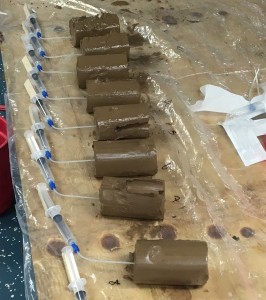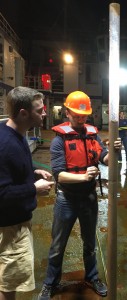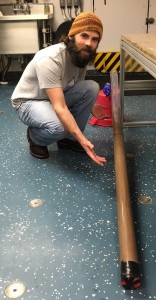by Jake Beam, Bigelow Laboratory for Ocean Sciences
I want to understand how microbes are relevant to the carbon cycle in energy-limited, deep-sea muds, and what they are eating down in the eternal darkness of the abyss.
After a few days steaming from Honolulu across the wide expanse that is the Pacific Ocean, we had the chance to grab a mud sample 3 miles below the sea surface in a region called the North Pacific Gyre.
This is no ordinary mud, however. Actually, it is quite extraordinary. At this location the rate at which new sediment is added to the mud is extremely slow. About 4 feet of new sediment is added every 1 million years. So we are looking at mud that has been around well before modern humans first appeared on Earth (not out of thin air, of course).
So this is what I’m thinking about as I hold these mud samples in my hand. Human hands have probably never touched them. It’s almost a feeling of reverence for this mud, it is really special.
Okay, this mud is really old, that’s cool, but what do we want to know about it in particular?
Prior work has shown that these muds accumulate new sediment at extremely slow rates. These slow rates tells us that there probably isn’t a lot of food (organic carbon) around for microbes to eat. This is also evident when we look at oxygen in these muds. Oxygen penetrates many feet below the seafloor (Røy et al., 2012)—this tells us that the microbes lack the food necessary to consume all the oxygen. This type of system is what is referred to as energy-limited or oligotrophic. Oligotrophic oceanic regions cover about 42 % of the seafloor, but only contain 10 % of the total amount of microbes in the seafloor (Kallmeyer et al., 2012). So the big question here is: how do microbes under extreme energy limitation make a living?
Microorganisms from the environment are notoriously difficult to grow in the laboratory, especially ones that come up from 3 miles below the sea surface and live in energy-limited mud. However, we have a way around this problem. We can sequence the genomes (DNA) of individual microbes and reconstruct their metabolisms to understand what they are actually eating.
There are several ways to accomplish this. First we can extract all the DNA from the mud and sequence it, then attempt to reconstruct all the DNA fragments to different populations of microbes. Reconstructing one microbe’s DNA is kind like putting together the pieces of a jigsaw puzzle. Attempting to reconstruct the DNA fragments from different microbial populations is more like mixing about a million different jigsaw puzzles together without the nice picture on the front of the box to help decode the correct answer. This can be problematic, but modern computers and programs are getting better every day at accomplishing this task.

Rhizons attached to the cores extract ancient water in the mud for analysis. Beam will use these water samples to see how much iron is in pore water. Photo by Jake Beam.
Single cell genomics is a clever way around trying to reconstruct microbial DNA. Like before, we start with millions of jigsaw puzzles, but this time the pieces stay in their individual boxes and don’t get mixed together. Individual microbial cells from the sample are sorted into tiny wells on a plate by a machine called a fluorescence-activated cell sorter. Next, we can break open the cells and sequence their individual DNA without mixing it with the DNA from other cells. This allows us to definitively link pieces of DNA to a specific microbe and a specific metabolic function, giving us insight into what the organism is eating and doing in its environment.
Although DNA provides us the potential for what a microbe can do, it doesn’t reveal any information about its activity in the environment. But it can lead us down the right road, instead of driving blindly in the dark.

Ben Urann and Thomas Kelly retrieve the gravity core as it comes out of the water. Photo by Jake Beam.
It shouldn’t be understated how awesome the Sikuliaq crew was during this operation, and how well everyone (science team included) came together to accomplish grabbing over 3 feet of mud from 3 miles below the sea. This may sound easy, but it is very difficult to accomplish. We don’t work in isolated islands, and it really showed during this recent coring operation. The science is great, but what’s really important are the people involved (crew and science team). I think the more you communicate with everyone on the ship, the more you come to appreciate the experience and the science.
Kallmeyer, J et al. (2012) Global distribution of microbial abundance and biomass in subseafloor sediment. Proceeding of the National Academy of Sciences, 109, 16213-16216. doi: 10.1073/pnas.1203849109
Røy H et al. (2012) Aerobic Microbial Respiration in 86-Million-Year-Old Deep-Sea Red Clay. Science, 336, 992-995. doi:10.1126/science.1219424


